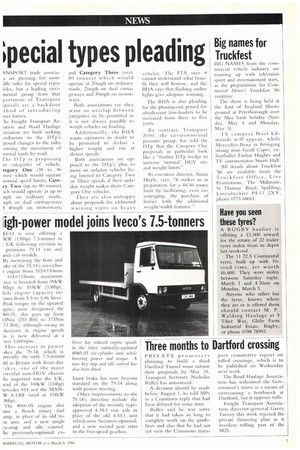;pedal types pleadin
Page 5

If you've noticed an error in this article please click here to report it so we can fix it.
ANSPORT trade associas are pressing for more ible rules for special types ides, but a leading envimental group fears that partment of Transport oposals are a backdoor thod of introducing vier lorries.
'he Freight Transport Asiation and Road Haulage tsciatiors are both seeking zridinents to the DTp's ,posed changes to the rules lolling the movement of lormal loads by road.
rhe DTp is proposing cc categories of vehicle. tegory One (38 to 46 fles) which would operate normal speed linnts; Catery Two (up to 80 tonnes) ich would operate at up to nph on ordinary roads, riph on dual carriageways
40inpli on motorways; and Category Three (over 80 tonnes) which would operate at 20mph on ordinary roads, 25mph on dual carriageways and 30mph on motorways.
Both associations say they want au I overlap between categories to be permitted as it is not always possible to weigh vehicles on loading.
Additionally, the RHA wants operators in doubt to be permitted to declare a higher weight and run at slower speeds.
Both associations are opposed to the DTp's plan to insist on unladen vehicles being limited to Category Two or Three speeds if their unladen weight makes them Category One vehicles.
They are also unhappy about proposals for additional warning signs on heavy vehicles. The FTA says it cannot understand what benefit they will bestow, and the RHA says that flashing amber lights give adequate warning.
The RI IA is also pleading for the phasing-out period for obsolescent low-loaders to be increased from three to five yea N.
By contrast, Transport 2000, the environmental pressure group, has told the DTp that the Category One proposals in particular look like a "further DTp wedge to increase 'normal' HGV size and weight limits".
Its executive director, Susan Hoyle, says: "It strikes us as preparation for a 44/46 tonne limit by facilitating, even encouraging, the purchase of lorries with the additional weight/width features."






































































